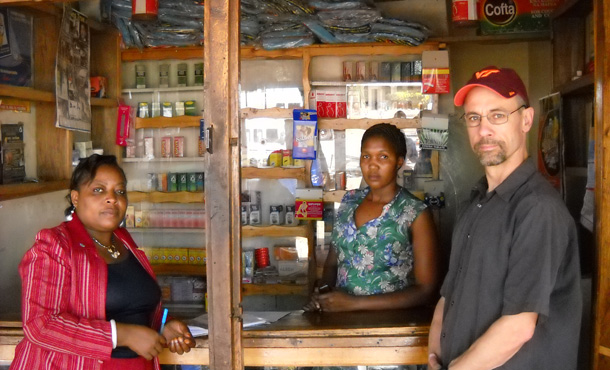An Eastern Mennonite University (EMU) economics professor is a major player in an impassioned debate among malaria experts around the world about the best way to reduce the incidence of malaria.
Chris D. Gingrich, who teaches in EMU’s business and economics department and MBA program, says everyone agrees that malaria is the largest health problem in sub-Saharan Africa, causing 300-500 million clinical episodes per year and claiming more than 1.5 million lives, including more children under age five than any other illness.
And, he adds, everyone agrees that insecticide-treated nets (ITNs) are the most cost-effective defense against malaria yet developed.
But the experts diverge on how to get ITNs distributed and put to use, as widely and as quickly as possible.
Jeffrey Sachs, a famous economist and public health advocate affiliated with Columbia University, has been campaigning for an expenditure of $3 billion per year to fund the free distribution of enough ITNs to cover every man, woman and child every night in Africa, reported the Oct. 26, 2007, issue of Science. (The species of mosquito that spreads malaria feeds mostly between 11 p.m. and 4 a.m.)
The Sachs “give-nets-to-everyone” approach has been backed by certain public policy researchers and epidemiologists working out some of the best-known institutes in the world, including the Harvard School of Public Health and the University of California Los Angeles.
Gingrich and his three colleagues – two based in Britain and one in Tanzania – are less certain that free net distribution is the best long-term, most sustainable solution for developing countries. They are among the first to collect and present “empirical evidence regarding the economics of ITN (insecticide-treated nets) delivery.”
In their latest article – “Price subsidies and the market for mosquito nets in developing countries: A study of Tanzania’s discount voucher scheme” – published in Elsevier’s Social Science & Medicine in June 2011, the Gingrich team reported that a nationwide voucher system used in Tanzania, whereby consumers pay a fraction of the cost of a mosquito net, had caused net purchases to increase from 18 to 62 percent among targeted households.
Here’s how the voucher scheme has worked in Tanzania since 2005: When pregnant women go for their prenatal check-ups, offered free under the government-supported health system, they get a voucher (printed and supplied to clinics by the non-profit organization Mennonite Economic Development Associates). Similarly, caregivers of infants receive a voucher at the time of a child’s measles vaccine. In 2010, this voucher covered 90 percent of the cost of buying an ITN.
The women can take this voucher to any participating retailer – it’s usually a small local shop owned by someone who supplies them with the basics, like soap, sugar and batteries – and until recently the women could choose the color, style, fabric type and such that they prefer (yes, mosquito nets come in different brands, models and designs). They then hand over their voucher and walk away with a net that retails for maybe $5 for as little as $.50 out of their pockets.
Pregnant women and infants are targeted for the Tanzanian voucher program, explains Gingrich, because they are more likely to die from an episode of malaria than are non-pregnant women, older children and men.
Gingrich, who has traveled to Tanzania on three separate occasions for his research, believes that consumers are more likely to value and use an ITN, if the method of distribution takes into account the “dignity of being able to make your own choice.”
However, recent changes in the program include supplementary distribution of free nets and a move toward uniform net size, color, and design. “I don’t want to be told what kind of car to drive, and I believe women [in Tanzania] don’t want to be told what kind of net they get to have,” says Gingrich.
“When donors conduct large-scale distribution of free nets, it is true that nets will reach more people very quickly, but I am not convinced that they end up being used as intended over the long term,” he says. “A couple of weeks ago I was in a region where nets had been widely distributed for free, and I saw them used for fencing, in vegetable gardens and as soccer goals.”
Gingrich does his research with Kara G. Hanson and Tanya J. Marchant of the London School of Hygiene & Tropical Medicine and with Hadji Mponda who recently became Tanzania’s national minister of health. They previously had an article on this subject published in the July 21, 2010, issue of Health Policy and Planning, a bi-monthly issued by Oxford University Press. The article was entitled “Household demand for insecticide treated bednets in Tanzania and policy options for increasing uptake.”
Gingrich brings to his work considerable experience as a Mennonite Central Committee worker on development issues, with three years in Haiti and two in Nepal. He holds a BS and MS in agricultural economics from the University of Illinois and a PhD in economics from Iowa State University.
His malaria-net research was supported by Mennonite Economic Development Associates during a 2007-2008 sabbatical from EMU. In previous years, Gingrich focused his research on the effectiveness and sustainability of microfinance programs and the relationship between economic globalization and agricultural development.
